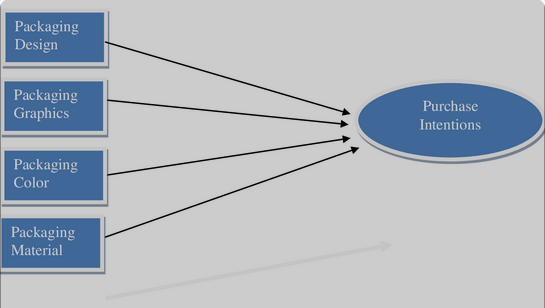Packaging design plays a significant role in influencing consumers’ purchase decisions. It serves as a critical touchpoint between the brand and the consumer, impacting perceptions, attracting attention, and conveying information. The purpose of this study is to examine Influence of packaging design on purchase decisions:

Visual Appeal:
Eye-catching and visually appealing packaging grabs consumers’ attention. Vibrant colors, unique shapes, and distinctive graphics can make a product stand out on the shelves, prompting consumers to notice and consider it among competing options.
Brand Recognition:
Consistent and recognizable packaging reinforces brand identity. When consumers can easily identify a product based on its packaging, it builds trust and loyalty. Strong brand recognition can influence repeat purchases as consumers become familiar and comfortable with a particular brand’s packaging.
Communication of Information:
Packaging design conveys essential information about the product, such as features, benefits, ingredients, usage instructions, and nutritional facts. Clear and informative packaging helps consumers make informed decisions, fostering trust in the product and brand.
Perceived Quality:
High-quality and well-designed packaging can create a perception of product quality. Consumers often associate well-crafted and premium packaging with the idea that the product inside is also of high quality. This can influence purchasing decisions, especially for products in competitive markets.
Differentiation and Brand Positioning:
Packaging design allows a brand to differentiate itself from competitors and communicate its unique selling propositions. The design can convey messages about the brand’s values, positioning the product in a way that resonates with the target audience.
Emotional Connection:
Packaging design can evoke emotions and create a connection with consumers. Whether through nostalgia, humor, or a sense of luxury, emotional engagement through packaging design can influence consumers’ feelings toward a product, impacting their decision to purchase.
Practicality and Functionality:
Packaging design influences convenience and usability. Easy-to-open, resealable, or eco-friendly packaging can enhance the overall consumer experience, making the product more appealing and contributing to positive purchase decisions.
Cultural Sensitivity:
Packaging design needs to be culturally sensitive to resonate with diverse consumer bases. Understanding cultural preferences and incorporating elements that align with local values can enhance the appeal of a product to specific target markets.
Environmental Considerations:
Sustainable and eco-friendly packaging designs are increasingly influencing purchase decisions. As environmental awareness grows, consumers are more likely to choose products with packaging that aligns with their values, such as using recyclable materials or minimizing waste.
Limited Editions and Seasonal Packaging:
Limited editions or seasonal packaging designs create a sense of urgency and exclusivity. Consumers may be motivated to make a purchase to obtain a unique or time-sensitive version of a product, contributing to increased sales during specific periods.
In summary, packaging design is a powerful tool that goes beyond mere aesthetics. It plays a crucial role in influencing consumers’ perceptions, facilitating communication, and ultimately shaping purchase decisions. A well-executed packaging design aligns with the brand strategy, resonates with the target audience, and enhances the overall consumer experience.
